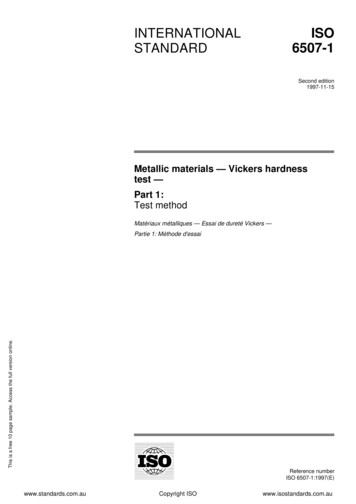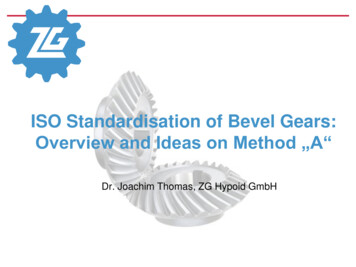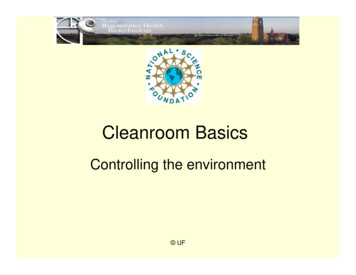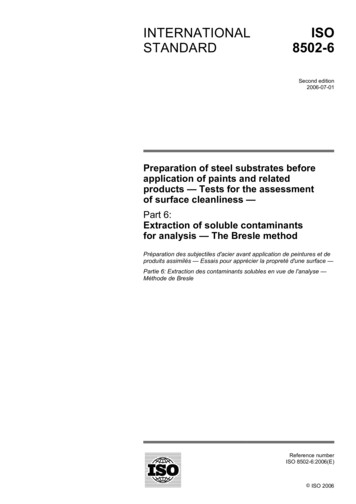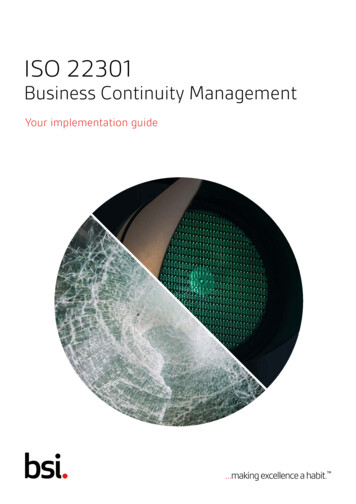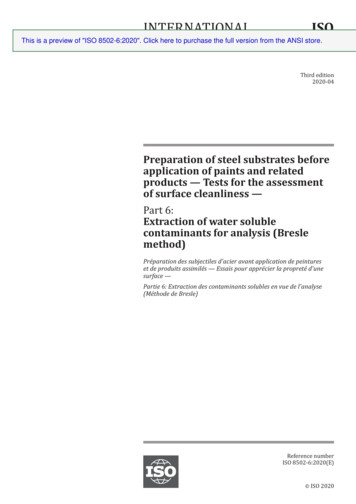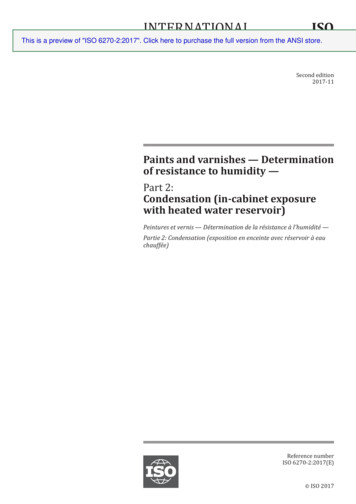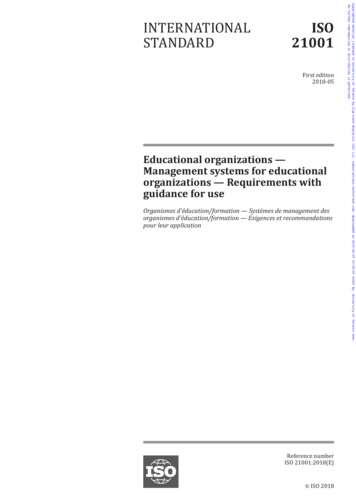
Transcription
ISO21001First edition2018-05Educational organizations —Management systems for educationalorganizations — Requirements withguidance for useOrganismes d'éducation/formation — Systèmes de management desorganismes d'éducation/formation — Exigences et recommandationspour leur applicationCopyrighted material licensed to University of Toronto by Clarivate Analytics (US) LLC, subscriptions.techstreet.com, downloaded on 2019-06-29 10:39:39 0000 byNo further reproduction or distribution is permitted.INTERNATIONALSTANDARDUniversity of Toronto User.Reference numberISO 21001:2018(E) ISO 2018
Copyrighted material licensed to University of Toronto by Clarivate Analytics (US) LLC, subscriptions.techstreet.com, downloaded on 2019-06-29 10:39:39 0000 byNo further reproduction or distribution is permitted.ISO 21001:2018(E) University of Toronto User.COPYRIGHT PROTECTED DOCUMENT ISO 2018All rights reserved. Unless otherwise specified, or required in the context of its implementation, no part of this publication maybe reproduced or utilized otherwise in any form or by any means, electronic or mechanical, including photocopying, or postingon the internet or an intranet, without prior written permission. Permission can be requested from either ISO at the addressbelow or ISO’s member body in the country of the requester.ISO copyright officeCP 401 Ch. de Blandonnet 8CH-1214 Vernier, GenevaPhone: 41 22 749 01 11Fax: 41 22 749 09 47Email: copyright@iso.orgWebsite: www.iso.orgPublished in Switzerlandii ISO 2018 – All rights reserved
Contents PageForeword.vIntroduction. vi1234567Normative references. 1Terms and definitions. 1Context of the organization. 74.1Understanding the organization and its context. 74.2Understanding the needs and expectations of interested parties. 74.3Determining the scope of the management system for educational organizations. 84.4Management system for educational organizations (EOMS). 8Leadership. 95.1Leadership and commitment. 95.1.1General. 95.1.2Focus on learners and other beneficiaries. 95.1.3Additional requirements for special needs education. 105.2Policy. 105.2.1Developing the policy. 105.2.2Communicating the policy. 105.3Organizational roles, responsibilities and authorities. 10Planning. 116.1Actions to address risks and opportunities. 116.2Educational organization objectives and planning to achieve them. 126.3Planning of changes. 12Support. 137.1Resources. 137.1.1General. 137.1.2Human resources. 137.1.3Facilities. 137.1.4Environment for the operation of educational processes. 147.1.5Monitoring and measuring resources. 147.1.6Organizational knowledge. 157.2Competence. 167.2.1General. 167.2.2Additional requirements for special needs education. 167.3Awareness. 167.4Communication. 177.4.1General. 177.4.2Communication purposes. 177.4.3Communication arrangements. 177.5Documented information. 187.5.1General. 187.5.2Creating and updating. 187.5.3Control of documented information. 18Operation. 198.1Operational planning and control. 198.1.1General. 198.1.2Specific operational planning and control of educational products and services.208.1.3Additional requirements for special needs education. 208.2Requirements for the educational products and services. 208.2.1Determining the requirements for the educational products and services. 208.2.2Communicating the requirements for the educational products and services. 21 ISO 2018 – All rights reserved iiiUniversity of Toronto User.8Scope. 1Copyrighted material licensed to University of Toronto by Clarivate Analytics (US) LLC, subscriptions.techstreet.com, downloaded on 2019-06-29 10:39:39 0000 byNo further reproduction or distribution is permitted.ISO 21001:2018(E)
8.38.48.59Performance evaluation.309.1Monitoring, measurement, analysis and evaluation. 309.1.1General. 309.1.2Satisfaction of learners, other beneficiaries and staff. 319.1.3Other monitoring and measuring needs. 319.1.4Methods for monitoring, measurement, analysis and evaluation. 329.1.5Analysis and evaluation. 329.2Internal audit. 339.3Management review. 339.3.1General. 339.3.2Management review inputs. 339.3.3Management review outputs. 34Improvement.3410.1 Nonconformity and corrective action. 3410.2 Continual improvement. 3510.3 Opportunities for improvement. 35Annex A (normative) Additional requirements for early childhood education.36Annex B (informative) Principles for an EOMS.39Annex C (informative) Classification of interested parties in educational organizations.49Annex D (informative) Guidelines for communication with interested parties.51Annex E (informative) Processes, measures and tools in educational organizations.56Annex F (informative) Example of mapping to regional standards.59Annex G (informative) Health and safety considerations for educational organizations.62Bibliography. 63iv ISO 2018 – All rights reservedUniversity of Toronto User.108.68.78.2.3Changes to requirements for the educational products and services. 21Design and development of the educational products and services. 218.3.1General. 218.3.2Design and development planning. 228.3.3Design and development inputs. 228.3.4Design and development controls. 228.3.5Design and development outputs. 248.3.6Design and development changes. 24Control of externally provided processes, products and services. 248.4.1General. 248.4.2Type and extent of control. 258.4.3Information for external providers. 25Delivery of the educational products and services. 268.5.1Control of delivery of the educational products and services. 268.5.2Identification and traceability. 288.5.3Property belonging to interested parties. 298.5.4Preservation. 298.5.5Protection and transparency of learners’ data. 298.5.6Control of changes in the educational products and services. 29Release of the educational products and services. 29Control of the educational nonconforming outputs. 30Copyrighted material licensed to University of Toronto by Clarivate Analytics (US) LLC, subscriptions.techstreet.com, downloaded on 2019-06-29 10:39:39 0000 byNo further reproduction or distribution is permitted.ISO 21001:2018(E)
ForewordISO (the International Organization for Standardization) is a worldwide federation of national standardsbodies (ISO member bodies). The work of preparing International Standards is normally carried outthrough ISO technical committees. Each member body interested in a subject for which a technicalcommittee has been established has the right to be represented on that committee. Internationalorganizations, governmental and non-governmental, in liaison with ISO, also take part in the work.ISO collaborates closely with the International Electrotechnical Commission (IEC) on all matters ofelectrotechnical standardization.The procedures used to develop this document and those intended for its further maintenance aredescribed in the ISO/IEC Directives, Part 1. In particular the different approval criteria needed for thedifferent types of ISO documents should be noted. This document was drafted in accordance with theeditorial rules of the ISO/IEC Directives, Part 2 (see www .iso .org/directives).Attention is drawn to the possibility that some of the elements of this document may be the subject ofpatent rights. ISO shall not be held responsible for identifying any or all such patent rights. Details ofany patent rights identified during the development of the document will be in the Introduction and/oron the ISO list of patent declarations received (see www .iso .org/patents).Any trade name used in this document is information given for the convenience of users and does notconstitute an endorsement.For an explanation on the voluntary nature of standards, the meaning of ISO specific terms andexpressions related to conformity assessment, as well as information about ISO's adherence to theWorld Trade Organization (WTO) principles in the Technical Barriers to Trade (TBT) see the followingURL: www .iso .org/iso/foreword .html.This document was prepared by Project Committee PC/288, Educational organizations managementsystems - Requirements with guidance for use.Copyrighted material licensed to University of Toronto by Clarivate Analytics (US) LLC, subscriptions.techstreet.com, downloaded on 2019-06-29 10:39:39 0000 byNo further reproduction or distribution is permitted.ISO 21001:2018(E) University of Toronto User. ISO 2018 – All rights reserved v
Introduction0.1 GeneralThis document provides a common management tool for organizations providing educational productsand services capable of meeting learners' and other beneficiaries' requirements.0.2 RelevanceThere is a critical and continuous need for educational organizations to evaluate the degree to whichthey meet the requirements of learners and other beneficiaries, as well as other relevant interestedparties and to improve their ability to continue to do so.NOTEA classification of interested parties in educational organizations is provided in Annex C.Although educational organizations and learners worldwide are the main beneficiaries of thisdocument, all interested parties will benefit from standardized management systems in educationalorganizations.EXAMPLEEmployers who sponsor and encourage staff to participate in educational services can alsobenefit from this document.The potential benefits to an organization of implementing a management system for educationalorganizations (EOMS) based on this document are:better alignment of objectives and activities with policy (including mission and vision);c)more personalized learning and effective response to all learners and particularly to learners withspecial education needs, distance learners and lifelong learning opportunities;e)increased credibility of the organization;b) enhanced social responsibility by providing inclusive and equitable quality education for all;d) consistent processes and evaluation tools to demonstrate and increase effectiveness and efficiency;f)a means that enables educational organizations to demonstrate their commitment to effectiveeducational management practices;g) a culture for organizational improvement;h) harmonization of regional, national, open, proprietary, and other standards within an internationalframework;i)j)widened participation of interested parties;stimulation of excellence and innovation.0.3 Relationship between this document and other International StandardsThis document is a stand-alone management system standard, aligned with ISO 9001. It focuses on themanagement systems of educational organizations as well as the impact of these on learners and otherrelevant interested parties.This document conforms to ISO’s requirements for management system standards. These requirementsinclude a high level structure, identical core text, and common terms with core definitions, designed tobenefit users implementing multiple ISO management system standards.This document can be implemented alongside regional, national, open, proprietary and other standardsor related documents.NOTEAnnex F provides an example of how to implement this document alongside the European QualityAssurance Framework for Vocational Education and Training (EQAVET).vi ISO 2018 – All rights reservedUniversity of Toronto User.a)Copyrighted material licensed to University of Toronto by Clarivate Analytics (US) LLC, subscriptions.techstreet.com, downloaded on 2019-06-29 10:39:39 0000 byNo further reproduction or distribution is permitted.ISO 21001:2018(E)
0.4 Principles for an EOMSThis EOMS entails the following management principles:a)focus on learners and other beneficiaries;c)engagement of people;e)improvement;b) visionary leadership;d) process approach;f)evidence-based decisions;g) relationship management;h) social responsibility;i)j)accessibility and equity;ethical conduct in education;k) data security and protection.NOTEThe details of these principles are analysed in Annex B.0.5 Process approach0.5.1 GeneralUnderstanding and managing interrelated processes as a system contributes to the organization’seffectiveness and efficiency in achieving its intended results. This approach enables the organizationto control the interrelationships and interdependencies among the processes of the system, so that theoverall performance of the organization can be enhanced.The process approach involves the systematic definition and management of processes, and theirinteractions, so as to achieve the intended results in accordance with the policy, objectives and strategicplan of the organization. Management of the processes and the system as a whole can be achieved usingthe PDCA cycle (see 0.5.2) with an overall focus on risk-based thinking (see 0.5.3) aimed at takingadvantage of opportunities and preventing undesirable results. The application of the process approachin an EOMS enables:— understanding and consistency in meeting requirements;— the consideration of processes in terms of added value;— the achievement of effective process performance;— improvement of processes based on evaluation of data and information.Figure 1 gives a schematic representation of any process and shows the interaction of its elements. Themonitoring and measuring check points, which are necessary for control, are specific to each processand will vary depending on the related risks. ISO 2018 – All rights reserved viiUniversity of Toronto User.This document promotes the adoption of a process approach when developing, implementing andimproving the effectiveness of an EOMS, to enhance learner and other beneficiary satisfaction bymeeting learner and other beneficiary requirements. Specific requirements considered essential to theadoption of a process approach are included in 4.4.Copyrighted material licensed to University of Toronto by Clarivate Analytics (US) LLC, subscriptions.techstreet.com, downloaded on 2019-06-29 10:39:39 0000 byNo further reproduction or distribution is permitted.ISO 21001:2018(E)
Figure 1 — Schematic representation of the elements of a single process (assessment of theeducational effectiveness process)0.5.2 Plan-Do-Check-Act cycleThe Plan-Do-Check-Act (PDCA) cycle can be applied to all processes and to the EOMS as a whole.Figure 2 illustrates how Clauses 4 to 10 can be grouped in relation to the PDCA cycle.Copyrighted material licensed to University of Toronto by Clarivate Analytics (US) LLC, subscriptions.techstreet.com, downloaded on 2019-06-29 10:39:39 0000 byNo further reproduction or distribution is permitted.ISO 21001:2018(E) University of Toronto User.viii ISO 2018 – All rights reserved
Numbers in brackets refer to clauses in this document.Figure 2 — Representation of the structure of this document in the PDCA cycleThe PDCA cycle can be briefly described as follows:— Plan: establish the objectives of the system and its processes, and the resources needed to deliverresults in accordance with learners' and other beneficiaries' requirements and the organization’spolicies, and identify and address risks and opportunities;— Do: implement what was planned;— Check: monitor and (where applicable) measure processes and the resulting products and servicesagainst policies, objectives, requirements and planned activities, and report the results;— Act: take actions to improve performance, as necessary.0.5.3 Risk-based thinkingRisk-based thinking is essential for achieving an effective EOMS. To conform to the requirements of thisdocument, an organization needs to plan and implement actions to address risks and opportunities.Addressing both risks and opportunities establishes a basis for increasing the effectiveness of thequality management system, achieving improved results and preventing negative effects. ISO 2018 – All rights reserved ixUniversity of Toronto User.NOTECopyrighted material licensed to University of Toronto by Clarivate Analytics (US) LLC, subscriptions.techstreet.com, downloaded on 2019-06-29 10:39:39 0000 byNo further reproduction or distribution is permitted.ISO 21001:2018(E)
Opportunities can arise as a result of a situation favourable to achieving an intended result, e.g. a setof circumstances that allow the organization to attract learners and other beneficiaries, develop newproducts and services, reduce waste or improve productivity. Actions to address opportunities can alsoinclude consideration of associated risks. Risk is the effect of uncertainty and any such uncertainty canhave positive or negative effects. A positive deviation arising from a risk can provide an opportunity,but not all positive effects of risk result in opportunities.0.6 Organizational mission, vision and strategyFigure 3 illustrates EOMS strategy as related to mission and vision.Figure 3 — EOMS strategy as related to mission and vision0.7 Additional requirements and guidanceAnnex A specifies additional requirements for early childhood education for organizations that providethis service.Annex B outlines the principles for an EOMS.Annex C provides a classification of interested parties.Annex D provides guidelines for communication with interested parties.Annex E provides guidance on processes, measures and tools in educational organizations.Annex F gives an example of mapping to regional standards.Annex G outlines health and safety considerations for educational organizations.x ISO 2018 – All rights reservedUniversity of Toronto User.The EOMS policy statements are framed by the organization’s culture (the complete set of beliefs andvalues that condition its behaviour) and by the EOMS principles. In turn, the EOMS policy statementsprovide the framework for the establishment of the EOMS objectives, which are periodically revisedto ensure the organization’s mission is effectively and efficiently accomplished while walking thecontinuous path towards the achievement of the organization’s vision. The articulation of theseelements is usually called a strategy.Copyrighted material licensed to University of Toronto by Clarivate Analytics (US) LLC, subscriptions.techstreet.com, downloaded on 201
ISO 21001:2018(E) Foreword. ISO (the International Organization for Standardization) is a worldwide federation of national standards . bodies (ISO member bodies). The work of preparing International Standards is normally carried out through ISO technical committees. Each



